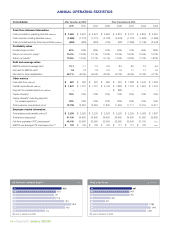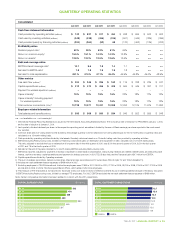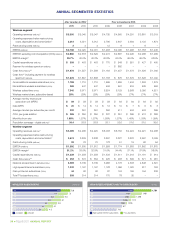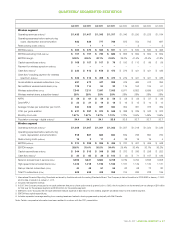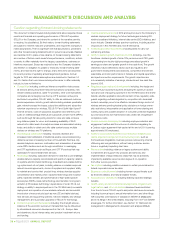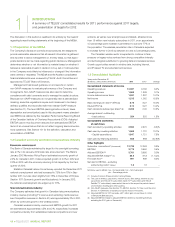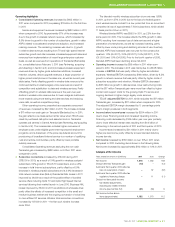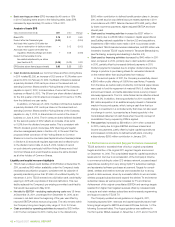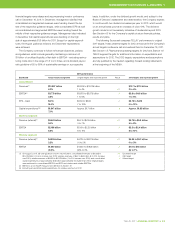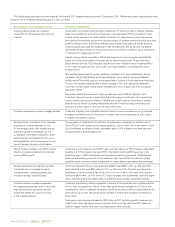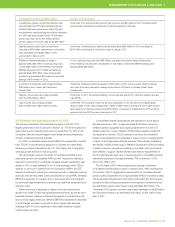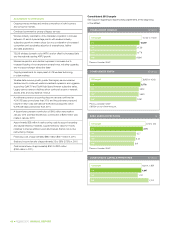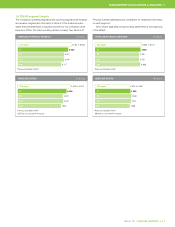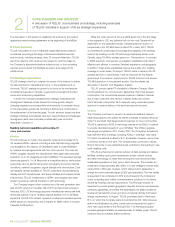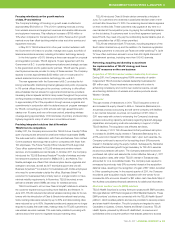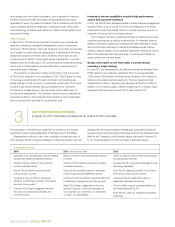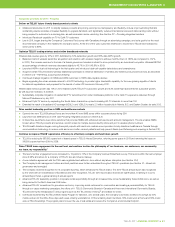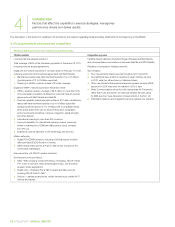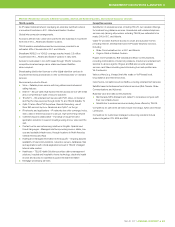Telus 2011 Annual Report Download - page 48
Download and view the complete annual report
Please find page 48 of the 2011 Telus annual report below. You can navigate through the pages in the report by either clicking on the pages listed below, or by using the keyword search tool below to find specific information within the annual report.
44 . TELUS 2011 ANNUAL REPORT
The following key assumptions were made at the time the 2011 targets were announced in December 2010. Preliminary pension assumptions were
revised in the 2010 MD&A dated February 24, 2011, as noted.
Assumptions for 2011 original targets Results or expectations
Ongoing intense wireline and wireless
competition in both business and consumer
markets
Confirmed by: (i) Activities of the dominant Internet and TV service provider in Western Canada,
Shaw Communications, such as the introduction of new generation PVRs, increases in certain
Internet service speeds, more customization choices for TV, Internet and home phone services,
and continued promotional discounts to new subscribers; (ii) wireless entrants pursuing subscriber
growth by using forms of unlimited and flat-rate voice, text and data plans, as well as adopting
a device subsidy approach and beginning to offer smartphones; and (iii) the loss of a federal
government wireless contract to a low-priced bid by an incumbent competitor, which contributed
11 basis points to higher churn in 2011.
Despite ongoing intense competition, TELUS has experienced more moderate residential NAL
losses due to the positive effect of bundled service offers including Optik TV and Optik High
Speed Internet services. TELUS has also experienced more moderate losses in business NALs
in 2011 when compared to 2010, due in part to the implementation of wholesale lines in the
first half of 2011.
Nine facilities-based wireless carriers operated in Canada in 2011: three established national
companies (TELUS, Bell Mobility and Rogers Wireless); two provincial incumbents (SaskTel
Mobility and MTS Mobility); and four new entrants (Wind, Videotron, Public Mobile and Mobilicity).
The four new entrants expanded their market coverage in 2011, and captured an estimated
more than one-third share of total market net additions in 2011 or about 4% of the cumulative
subscriber market.
New entrant EastLink is expected to begin providing services in Atlantic Canada in 2012.
In contrast, Shaw announced in September that it had stopped construction of a conventional
wireless network and service in Western Canada due to high costs and other factors. Instead,
Shaw announced that it is building metropolitan area Wi-Fi networks using unlicensed public
spectrum to extend delivery of its services beyond the home.
Continued downward re-pricing of legacy services Confirmed. Ongoing price competition and net losses in network access lines, net of local rate
increases were reflected in an 8.1% decline in wireline voice local revenues and a 10% decline
in wireline long distance revenue.
Wireless industry penetration of the Canadian
popu lation to increase between 4.5 and
5.0 per centage points, with wireless industry
subscriber growth to accelerate due to a
combination of increased competition, accel -
erated adoption of smartphones and use of
data applications, and the emergence of new
types of wireless devices such as tablets
The popularity of smartphones is confirmed, as evidenced by a smartphone adoption rate of
74% of TELUS’ fourth quarter gross postpaid additions, up from 46% in the fourth quarter of 2010.
TELUS estimates the wireless industry penetration gain in 2011 is slightly lower than expected,
at approximately 4.3 percentage points.
TELUS wireless domestic voice ARPU erosion
offset by increases in data and international
roaming ARPU growth
Confirmed. A 9.4% decline in voice ARPU was more than offset by a 38% increase in data ARPU,
resulting in a 2.5% increase in blended ARPU. International roaming ARPU grew due to the
expanding base of HSPA devices and new international roaming agreements. CDMA devices,
which are a decreasing proportion of the subscriber base, have limited international roaming
capability as few countries outside Canada and the United States implemented this technology.
Wireless acquisition and retention expenses
to increase due to increases in loading
of smartphones, including upgrades, and
to support a larger subscriber base
Confirmed. Wireless COA per gross subscriber addition was $386 in 2011, up 10% from 2010,
while total COA costs were $694 million in 2011, up 16% from 2010. Retention spending as a
percentage of network revenue was 12.4% in 2011, up from 11.6% in 2010, while total retention
costs were $626 million, up 17% from 2010. These increases were substantially caused by higher
device subsidies arising from higher sales of smartphones and greater competitive intensity.
Continued wireline broadband expansion
and upgrades supporting Optik TV and Optik
High Speed Internet subscriber revenue
growth that offsets the continued erosion
in NAL-related revenues
Confirmed. See Building national capabilities in Section 2.2 for expansion and upgrade activities
in 2011. Total subscriptions to TELUS TV and high-speed Internet increased by 271,000 in 2011,
exceeding the 164,000 combined decrease in total NALs and dial-up Internet subscriptions for the
same period. As a result, TELUS had its first increase in total wireline customer connections in
seven years.
Total wireline data revenues increased by $310 million in 2011, including growth in revenue from
Optik TV and Optik High Speed Internet services, which more than offset the $173 million net
decline in legacy wireline voice local, long distance and other revenues.


